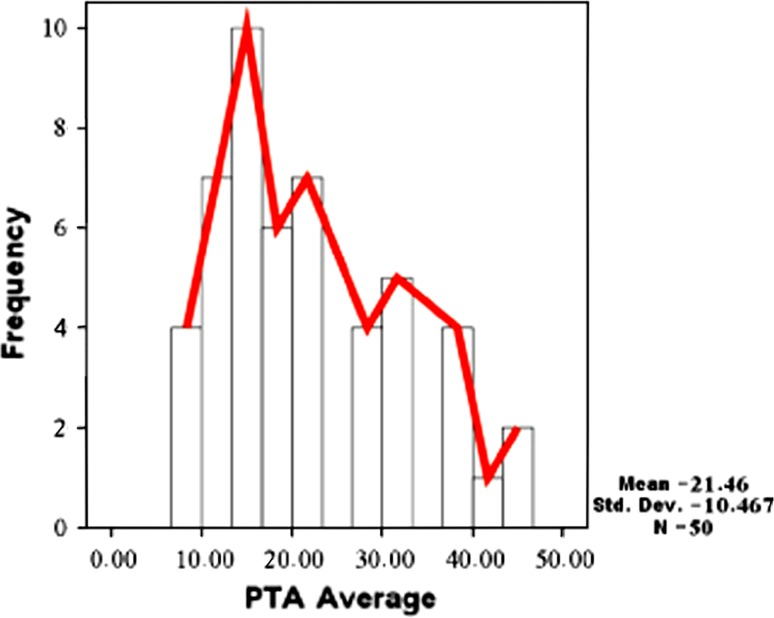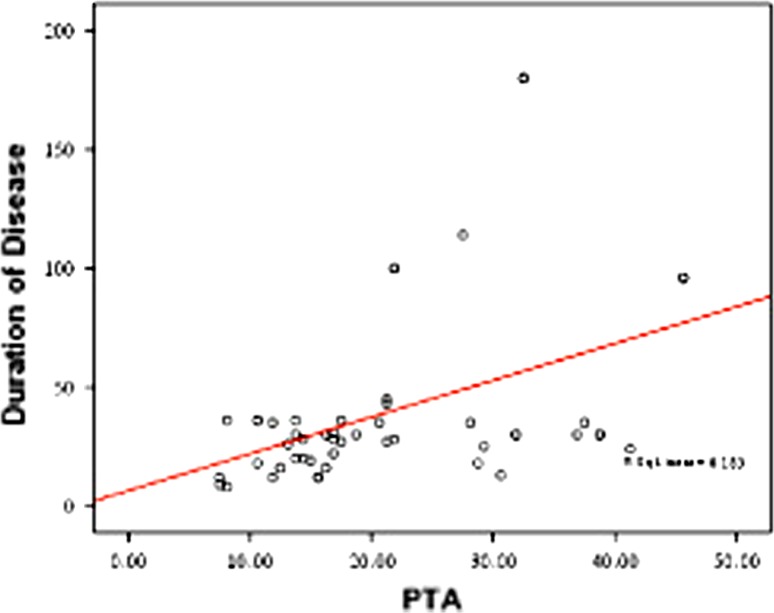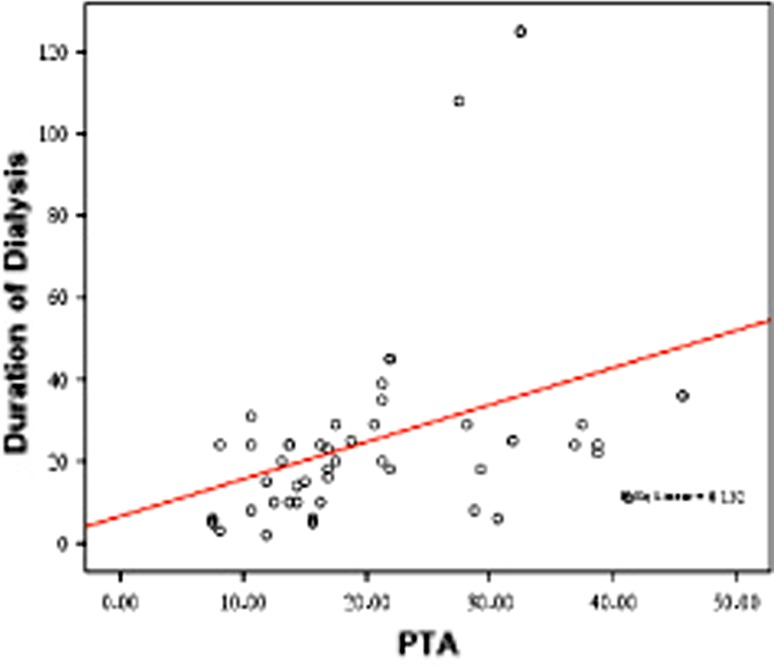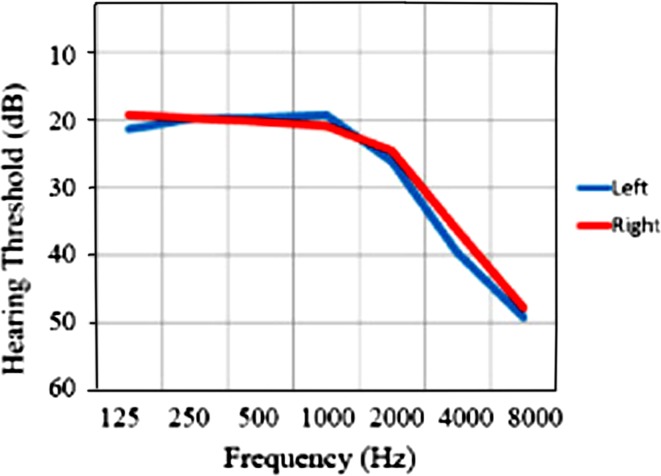Abstract
End stage renal failure patients, face to multiple complications. One of them is the involvement of auditory system. There are several proposed mechanisms for occurrence of hearing loss in these patients. There is no study performed in Iran for determining the status of hearing loss and results of audiometric tests in chronic renal failure patients. To assess prevalence, type and accompanying factors of auditory complications in end stage renal disease patients. Seventy chronic renal failure patients underwent clinical examination and audiometric tests. Their medical records reviewed to find out any contributing factor with auditory complications. There was higher prevalence of sensory neural hearing loss in CRF patients. The hearing loss was more obvious in higher frequencies. Its prevalence and severity increased with chronicity of renal failure and hemodialysis. There was not any difference regarding the sex. The hearing loss did not disturbed speech discrimination score and acoustic reflex. Sensory–neural hearing loss is common among CRF patients and deserves more attention than is paid by current approaches.
Keywords: Chronic renal failure, Hemodialysis, Hearing loss
Introduction
Chronic renal failure (CRF), affects many organs. The complications of CRF are due to the disease or effects of medications used for its treatment. Accumulation of uremic toxins and prolonged hemodialysis will affect almost every tissue, including auditory system [1].
The presence of hearing loss in CRF patients is mentioned before. This hearing loss is from sensory–neural type and usually is diagnosed in long term CRF patients and progresses in time [1, 2].
The effects of CRF on hearing can be divided in two categories: Effects of the disease and effects of hemodialysis. There are many proposed mechanisms for hearing loss due to CRF. The inner ear is a complex system that is dependent to homeostasis of water and electrolytes. Defect in cationic gradient of endolymphatic fluid will alter hearing properties. Endolymphatic hydropse is another proposed mechanism of hearing loss in CRF. Low frequency sensory–neural hearing loss (SNHL) that improves with hemodialysis may be due to this phenomenon [3].
There are many antigenic similarities between kidney and inner ear. Glomerular basement membrane and cochlear stria vascularis are both structurally and functionally similar. There are some diseases and syndromes (including Alport’s syndrome) that affect kidney and cochlea together. In additions, some drugs such as loop diuretics and aminoglycosides have both renal and cochlear effects and toxicities. In facts diuretics are used as a common medication in some CRF patients and their ototoxicity assumed to be one of the main mechanisms of hearing loss in CRF [4, 5].
Hemodialysis may have an important role in occurrence of hearing loss in CRF. Chronic dialysis results to accumulation amyloid materials in many tissues including inner ear. Aluminum toxicity that is seen in chronic dialysis patients also may have a role in hearing loss [6].
Considering the importance of hearing loss in CRF and the present diversity about the its presence, type, mechanisms, treatment and prognosis, this study conducted to answer some elementary questions and open the way for further studies.
Materials and Methods
The records 84 patients of Loghman Hakim Hospital Dialysis centre, reviewed in this cross sectional study. We collected demographic information of patients as well as history of the underlying and accompanying diseases, the onset time of CRF and hemodialysis, drug history and history of any diagnosed hereditary or acquired hearing loss or other auditory and vestibular diseases. A complete examination with an otologic microscope performed in all cases. The inclusion criteria were normal examination and absence of any history of previous known hearing loss due to CRF or other diseases. Seventy patients met inclusion criteria and entered the study.
Audiometric tests including Pure Tone Audiometry (PTA), Speech recognition threshold (SRT), Speech Discrimination Score (SDS), Tympanometry and Acoustic Reflex obtained in all cases. The results entered in an information sheet and analyzed using SPSS 15.0 software. The cases that were diagnosed to have hearing loss, compared with normal hearers considering age, sex, the onset time of CRF and hemodialysis.
Results
Seventy patients (37 males, 33 females) evaluated in this study. Mean age was 57.5 ± 15.9 (21–90) years. Most patients were in 4–7th decades of age. Considering normal hearing threshold at +20 dB, 23 patients (46%) had hearing loss. Mean PTA result in this group of patients was 21.46 (7.5–45.63) dB (Fig. 1).
Fig. 1.
Statistical properties of PTA results
Different properties of patients with and without hearing loss are shown in Table 1.
Table 1.
Comparison of CRF patients with and without hearing loss
| Total | With hearing loss | Without hearing loss | P Value | |
|---|---|---|---|---|
| Age | 57.5 ± 15.9 | 66.8 ± 10.5 | 49.7 ± 15.6 | <0.001 |
| Sex | 27 M/23F | 12 M/11F | 15 M/12F | NS |
| Duration of disease | 39.7 ± 37.9 | 58.4 ± 49.1 | 23.7 ± 9.5 | <0.003 |
| Duration of dialysis | 26.1 ± 26.1 | 38.5 ± 33.8 | 15.6 ± 8.5 | <0.004 |
| Right acoustic reflex | 98.6 ± 9.4 | 93.2 ± 8.7 | 102.1 ± 8.3 | <0.005 |
| Left acoustic reflex | 101.4 ± 5.7 | 101.1 ± 5.5 | 101.5 ± 5.9 | NS |
| Right SDS | 93.9 ± 6.3 | 90.8 ± 7.4 | 96.6 ± 3.5 | <0.002 |
| Left SDS | 92.2 ± 7.3 | 87.4 ± 7.6 | 96.3 ± 3.7 | <0.001 |
NS note significant
The correlation ratio between duration of disease and mean PTA of patients was 0.43 (P < 0.002). This ratio was 0.36 when duration of hemodialysis compared with mean PTA (P < 0.009). These results are shown in Figs. 2 and 3.
Fig. 2.
Correlation between hearing loss and duration of CRF
Fig. 3.
Correlation between hearing loss and duration of treatment with hemodialysis
High frequency hearing loss was the dominant shape of PTA graphs in this group of patients (Fig. 4).
Fig. 4.
The mean of hearing thresholds in our CRF patients at frequencies of 125–8,000 Hz. The hearing loss is obvious in higher frequencies
Discussion
In this group of patients, hearing loss defined as lower than 20 dB mean threshold of hearing in frequencies of 500, 1,000 and 2,000 Hz. With this definition, 46% of our patients had a degree of hearing loss. Anyway, sever and profound hearing losses were not diagnosed in any patient.
52.9% of our patients were male and 47.1% were female. Gender had not any significant correlation with hearing loss in CRF patients.
As aging is a significant risk factor of hearing loss even in healthy population, in this study we analyzed the relationship between age and hearing thresholds of our patients to avoid this kind of bias as much as possible. Although in a general aspect, the prevalence and severity of hearing loss were increased with age, this phenomenon was significant in ages over 65 years and most of our patients were younger than this.
The duration of CRF and hemodialysis (the number of months that the patient was treated with hemodialysis) had a very wide distribution. This enabled us to assess the correlation between hearing loss and duration of disease and its treatment. By putting the duration of CRF and hemodialysis in three ranges of 6–12 months, 1–2 years and 2–5 years, the distribution of these two variables became similar and any statistical analysis of one of them was distributable to the other. In patients who were affected by CRF less than 1 year, no case of hearing loss was found, in the other hand, the ones whose disease was diagnosed more than 2 years ago, all cases had a degree of hearing loss. Furthermore, the severity of hearing loss increased with increasing of the duration of CRF and this correlation was statistically significant. This is in contrast with a report by Henrich WL who stated that hearing loss is related with CRF, but its progression ceases with initiation of hemodialysis [5].
Hearing loss in our patient was dominant in higher frequencies. This finding is frequently reported in different studies [1, 5, 7].
Speech recognition threshold (SRT) results, in almost all patients were equal to values that anticipated regarding PTA results. Most patients had good speech discrimination and speech discrimination score (SDS) in more than 78% of cases were more than 80. This is in favor of proximal involvement of auditory system.
Contralateral acoustic reflex test performed in frequency of 1,000 Hz and was present in right side in 72% and in left side in 62% of cases. When this reflex was recordable, the sound amplitude that induced it was between 85 and 110 dB. This is similar with common population. So, we can emphasis that this test is not valuable in CRF patients. Anyway, the absence of recruitment is again in favor of proximal involvement of auditory system.
Conclusion
Sensory–neural hearing loss has a considerable prevalence in CRF patients. The severity of hearing loss increases with increase of the duration of renal failure but it is not correlated with age and gender. This loss involves higher frequencies most commonly and does not affect discrimination. It seems that hearing loss is a considerable aspect of patient care in chronic renal failure and these patients should undergo routine hearing monitoring tests.
References
- 1.Gatland D, Tucker B, Chalstrey S, Keene M, Baker L. Hearing loss in chronic renal failure-hearing threshold changes following haemodialysis. J R Soc Med. 1991;84:587–639. doi: 10.1177/014107689108401006. [DOI] [PMC free article] [PubMed] [Google Scholar]
- 2.Bains KS, Chopra H, Sandhu JS. Cochlear function in chronic kidney disease and renal transplantation: a longitudinal study. Transpl Proc. 2007;39(5):1465–1468. doi: 10.1016/j.transproceed.2007.02.085. [DOI] [PubMed] [Google Scholar]
- 3.Adler D, Fiehn W, Ritz E. Inhibition of Na+, K+-stimulated ATPase in the cochlea of the guinea pig. A potential cause of disturbed inner ear functions in terminal renal failure. Acta Otolaryngol. 1980;90(1–2):55–60. doi: 10.3109/00016488009131697. [DOI] [PubMed] [Google Scholar]
- 4.Mitschke H, Schmidt P, Zazgornik J, Kopsa H, Pils P. Effect of renal transplantation on uremic deafness: a long-term study. Audiology. 1977;16(6):530–534. doi: 10.3109/00206097709080024. [DOI] [PubMed] [Google Scholar]
- 5.Henrich WL, Thompson P, Bergstrom LV, Lum GM. Effect of dialysis on hearing acuity. Nephron. 1977;18(6):348–351. doi: 10.1159/000180854. [DOI] [PubMed] [Google Scholar]
- 6.Nikolopoulos TP, Kandiloros DC, Segas JV, Nomicos PN, Ferekidis EA, Michelis KE, Apostolopoulos NJ, Adamopoulos GK. Auditory function in young patients with chronic renal failure. Clin Otolaryngol Allied Sci. 1997;22(3):222–225. doi: 10.1046/j.1365-2273.1997.00890.x. [DOI] [PubMed] [Google Scholar]
- 7.Zeigelboim BS, Mangabeira-Albernaz PL, Fukuda Y. High frequency audiometry and chronic renal failure. Acta Otolaryngol. 2001;121(2):245–248. doi: 10.1080/000164801300043686. [DOI] [PubMed] [Google Scholar]






